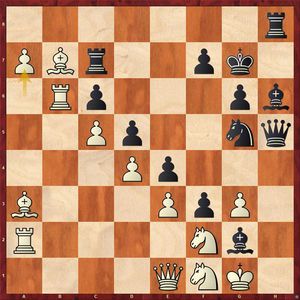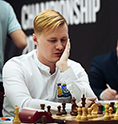Heavy Burden of Leadership
The Superfinal Rounds 7-9 review by Klementy Sychev
A fierce battle continues in the Russian Championship Superfinal, but the pandemic has introduced its lamentable adjustments to the usual flow of events: Moscow GM Mikhail Antipov had to step down from the race due to a positive test for coronavirus. According to the tournament regulations, all his remaining games are losses by forfeit. We wish him a quick recovery and move on to discussing the competition.
In round seven, the crucial match up for the final standings took place: Ian Nepomniachtchi defeated Sergey Karjakin thanks to a well-prepared novelty.
Nepomniachtchi – Karjakin
1.d4 Nf6 2.c4 e6 3.Nc3 Bb4 4.f3
This ambitious way to meet the Nimzo-Indian Defense has recently gained popularity.
4...d5
The mainline, and 4...c5 is also excellent. In this connection we should mention the Caruana-Aronian game from the Norway Chess tournament, in which the Armenian grandmaster brilliantly outplayed his opponent and scored an important victory after 5. d5 b5 6.e4 d6 7.Bd2 Bxc3 8.Bxc3 b4 9.Bd2 0-0 10. Ne2 Nh5 11. Be3 f5 12.dxe6 Bxe6 13. exf5 Rxf5 14. Qd2 Nd7, etc.
5.a3 Be7
The latest ripple of fashion. They thought Black is bound to go for 5...Bxc3+ 6. bxc3 c5 7. cxd5 Nxd5 8. dxc5 Qa5, and here two rounds later Sergey confidently defended his position against Vladimir Fedoseev: 9.e4 Nf6 10.Be3 0-0 11.Qb3 (also interesting is 11.a4, as in the game Caruana-Carlsen from the Magnus Tour: 11...Nfd7 12. Kf2 Nxc5 13. Qd6 b6 14. Bb5 Bd7 15. Ne2 Bxb5 16.Bxc5 bxc5 17.Qxc5; White got a huge advantage from the opening, but it was the world champion who triumphed in the game) 11...Nfd7 12.Bb5 Na6 13.Bxa6 Qxa6 14.a4 Ne5 15.Qb5 Qxb5 16.axb5 Bd7 17.Rb1 Rfc8 18.Ne2 Nd3+ 19.Kd2 Nxc5.
6.e4 dxe4 7.fxe4 c5 8.d5 exd5 9.exd5 0–0 10.Be2 Re8
Worthy of attention is 10...Bd6 11.Nf3 Bg4 12.0-0 Nbd7, and Black got an excellent position in Goryachkina – Oparin.
11.Nf3 Bg4 12.0–0 Nbd7 13.d6!
The most principled and committal decision: the d6-pawn can turn into both an asset and a liability.
In the case of 13.h3 Bxf3 14.Rxf3 Bd6 the game is double-edged due to the weakened dark squares in the white camp and the potential of lining up a battery on the b8-h2 diagonal.
13...Bf8 14.h3 Bh5
.jpg)
15.Bf4
An interesting novelty from the Nepomniachtchi.
They have only tested 15.Nb5 here, and this is an important cross-road:
1) 15...Re6 16.Bf4 a6 17.Nc7 Re4 18.Bh2 Rc8 19.g4 Bxg4 20.hxg4 Nxg4 21.Bd3 Nxh2 22.Bxe4 Nxf1 23.Qxf1 Bxd6 24.Nd5 is wrong, and Caruana-Alekseenko, Yekaterinburg 2020, the piece proved superior to three pawns;
2) 15...Qb6 looks very principled as Black does not mind the exchange sacrifice to get rid of an important pawn immediately. However, after 16.Nc7 Bxd6 17.Nxa8 Rxa8 18.Nh4 Bg6 19.Nxg6 (19.Nf5 Bxf5 20.Rxf5 Re8 is less precise, as in Vidit – Karjakin) 19...hxg6 20.Bf3 Be5 21.Be3 in Yarmula-Golubka, Pardubice 2020, White got the advantage and went on to win the game.
3) 15...Rb8! (the most precise) 16.Bf4 a6 17.Nc7 Re4 18.Bg3 Bxf3 19.Bxf3 Rd4 20.Qe1 Bxd6 21.Nd5 Bxg3 22.Qxg3 – as in Vidit – Aronian. White has sufficient compensation for the sacrificed pawn, but it is not easy for him to claim an advantage, so Ian tries to handle the position differently.
15...Qb6 16.b3!
It looks unattractive, but White's idea is to protect his position's main strength via Ra2-d2.
16...Rad8
The most straightforward, and also of interest is 16...Re6, and White's advantage in the arising complications is not easy to prove: 17.Nb5 Re4 18.Bh2 a6 19.Nc7 Rd8 or 17.Ng5 Bxe2 18.Nxe2 Ree8 19.Nc3 h6 20.Nf3 Re6.
17.Ra2 h6
17...Ne4?! fails to 18.Nd5.
The direct 17...Bxf3 18.Bxf3 Ne5 looks interesting, but after 19.Bg5 Rxd6 20.Nd5 Nxd5 21.Bxd5 the powerful d5-bishop allows to keep up pressure.
18.a4!
Ian contests the b5-square.
.jpg)
Suddenly, a critical moment has crept in, and Karjakin fails to take a proper decision.
18...Bxf3?
It was worth eliminating the knight's jump on b5 once and for all via 18...a6; after 9.a5 Qc6 20.g4 Bg6 21.Rd2 Ne4 22.Nxe4 Bxe4 the position is a dynamic equilibrium.
18...Qa5 is worth trying so as to exploit Aronian's idea to advantage after 19.Nb5 a6 20.Nc7 Re4 21.Bh2 Bxf3 22.Bxf3 Rd4, and Black is in good shape.
19.Bxf3 Ne5 20.Nb5!
It is probably this continuation that the ex-contender for the world crown missed in his calculations.
20...Bxd6?
A decisive error. Karjakin goes all out, but perishes in a complex confrontation.
20...Rd7, preparing the queen's retreat to d8, was the toughest defense. 20...Nxf3+ 21.Qxf3 looks interesting, but Black is in for a difficult ending after 21...Qc6 22.Qxc6 bxc6 23.Nxa7 Bxd6 24.Nxc6 Bxf4 25.Rxf4.
21.a5 Qa6 22.Rd2
It turns out that Black loses material, and Nepomniachtchi confidently pressed his advantage home:
22...Nxf3+ 23.Rxf3 Ne4 (23...Be7 24.Nc7+–) 24.Nxd6 Nxd2 25.Qxd2 Re6 26.Rd3 b6 27.Nf5 Rxd3 28.Qxd3 Qb7 29.Qd5 Qxd5 30.cxd5 Re1+ 31.Kf2 Rd1 32.Ke2 Black resigned.
However, Ian did not manage to build upon success: in the following round he had a hard time as White against Vladimir Fedoseev, and in round nine he suffered a crushing defeat from Daniil Dubov.
Dubov – Nepomniachtchi
1.d4 Nf6 2.c4 g6 3.Nc3 d5 4.cxd5 Nxd5 5.e4 Nxc3 6.bxc3 Bg7 7.Bb5+ c6 8.Ba4 b5
The most principled. 8...0-0 is safer.
9.Bb3 a5 10.Nf3 0–0 11.0–0 a4 12.Bc2 c5 13.Rb1 Nc6 14.d5!
This is an important improvement. Ian confidently solved his opening problems against Nakamura after 14.Be3 cxd4 15.cxd4 Bg4.
14...Ne5 15.Nxe5 Bxe5 16.Bh6 Ba6!?
An interesting sacrifice of exchange.
17.Bxf8 Kxf8
Black has full compensation thanks to the strong bishops and the weak c3-pawn, but Daniil launches an attack in his trademark style:
18.f4! Bxc3 19.Rf3 Qa5
Not the way to go. 19...Bd4+ 20.Kh1 Qd7 is less complicated.
20.e5 Kg8?
This is yet another blunder. He should have retreated 20...Kg7 to keep an eye on the g6-pawn in a number of lines.
21.Kh1 Rd8
.jpg)
Black seems to have a chance to get out in one piece, but Dubov delivers a series of crushing blows.
22.e6! fxe6 23.Bxg6! hxg6 24.Qc2
Winning an important tempo.
24...Bg7 25.Rg3!
The toughest continuation. 25.Qxg6 Qd2 26.Rg3 Qd4 27.Qxe6+ Kf8 28.Qxa6 Qxd5 29.h3 is also decent.
25...g5 26.Qg6 Qd2 27.Rxg5 Qc3 28.Qxe6+ Kf8 29.Re1!
The final touch. Now Black must part with the queen, and the 2018 Rapid World Champion did not have any problems converting.
29...Qxe1+ 30.Qxe1 Bf6 31.Qh4 Rd6 32.Qh7 Ke8 33.Qg8+ Kd7 34.Qa8 Bxg5 35.fxg5 c4 36.h4 b4 37.Qa7+ Ke8 38.Qb8+ Kf7 39.Qxb4 Rxd5 40.Qxa4 Black resigned.
Thanks to his competitor's failure, Karjakin is back for contention after having defeated Peter Svidler.
Karjakin – Svidler
.jpg)
Both opponents were up to the task in a difficult fight, but Svidler blunders in a strong time pressure
34...Qxg2??
The precise 34...Rd1+ 35.Rxd1 Qxd1+ 36.Qc1 (36.Ka2 Qd5+) 36...Qe2 leads the drawn queen ending. The white pawns on the kingside are vulnerable, and if protected by 37.Qg1, Black goes for the white king via 37...Qe4, maintaining the balance.
35.Re7+ Ka8 36.Qf6 Qg1+ 37.Ka2 Qg8+ 38.Rf7
Black stopped the clock without waiting to be checkmated soon after.
It is worth highlighting the intense confrontation between Nikita Vitiugov and Andrey Esipenko.
Vitiugov – Esipenko
1.e4 e5 2.Nf3 Nf6 3.Nxe5 d6 4.Nf3 Nxe4 5.Bd3
A rare but poisonous continuation
5...d5
The position after 5...Nf6 6.0–0 Be7 7.h3 0–0 8.c3 b6 9.Bc2 Bb7 10.d4 is evaluated as slightly better for White.
6.Qe2 Qe7 7.0–0 Nd6 8.Qd1
An attempt to keep up tension due to the presence of queens.
8.Re1 Qxe2 9.Rxe2+ Be7 promises nothing, as in Grischuk – Fedoseev.
8...Qd8 9.Re1+ Be7 10.c3 0–0 11.Bc2 c6 12.d4 Bf5 13.Bf4
13.Bxf5 Nxf5 14.Qb3 Qc7 15.Qc2 g6 16.Nbd2 Re8 17.Nf1 Nd7 18.Ng3 Nxg3 19.hxg3 Nf6 is complete equality seen in the Gunina – Harika game.
13...Bxc2 14.Qxc2 Na6 15.Nbd2 Nc7
.jpg)
16.h4!?
An interesting way to put pressure on Black's position. A similar idea allowed Nepomniachtchi to score an important win over Wang Hao in the Candidates Tournament.
There was complete equality in So – Caruana after 16.Re2 Re8 17.Rae1 Bf8 18.Ne5 Qf6 19.Bg3 Qf5 20.Qxf5 Nxf5
16...g6
This is a purpose-driven but risky plan: Andrey is after posting his knight on f5 and is not put off by his king's weakening.
White has nothing to hook to following the conservative 16...Re8 17.h5 h6.
17.h5 Nf5 18.Ne5 Bd6 19.Ndf3
19.hxg6 hxg6 20.Ndf3 is driven by the idea of stopping the opponent from ousting the knight by...f6.
19...f6 20.hxg6!?
This is an exciting piece sacrifice. Also not bad is 20. Nd3: White enjoys pressure without risk thanks to the exposed position of the black king.
20...fxe5 21.gxh7+ Kg7?
Esipenko must have blundered or underestimated the opponent's reply.
Bad is 21...Kxh7 22. dxe5, and White takes back a piece; however, he should have sidestepped 21...Kh8, and the arising complications show an approximate equilibrium in all lines: 22.Nxe5 Qf6 23.Nd7 Nxd4! (also not bad is 23...Qg7 24. Nxf8 Rxf8 25. Bxd6 Nxd6) 24.Nxf6 Nxc2 25.Bxd6 Rxf6 26.Bxc7 Rf7 27.Be5+ Kxh7 28.Rad1 Nxe1 29.Rxe1 Re8, and neither side finds it easy to make progress.
22.Rxe5!
It comes like a bolt from the blue! Black's position becomes critical.
22...Ne6?
22...Bxe5? loses to 23.Bxe5+ Kxh7 24.g4+–. Only 22...Qd7 was good enough to defend the position without any decisive blow to be found for White: 23.h8Q+ (23.g4 Ne6 24.Bh2 Ne7 25.Rae1 Rxf3 26.Rxe6 Bxh2+ 27.Kxh2 Rf7) 23...Kxh8 24.Rxf5 Bxf4 25.Rh5+ Kg8 26.g3 Qg7 27.Kg2 Rf7 28.Rah1 Raf8.
23.Rxe6
This is not bad, but a quicker way to success was 23.Rxf5 Nxf4 (23...Bxf4 24.Re1) 24.g3 Ng6 (24...Rxf5 25.Qxf5 Ng6 26.Re1 Qf6 27.Qg4+–) was the fastest way to succeed when the unexpected 25.h8Q+!! Rxh8 (25...Nxh8 26.Rg5+; 25...Kxh8 26.Rg5) 26.Ng5 seals the deal as the threats are too many for Black to deal with.
23...Bxf4 24.g3! Qd7
24...Bd6 is again strongly met by 25.h8Q+ Kxh8 26.Kg2, and white pieces are about to break into black's camp.
The counter piece sacrifice via 24...Qc7 looked decent, but precise play allows black to quell the offensive: 25.gxf4 Qxf4 26.Qe2 Kxh7 27.Kf1 Qg4 28.Ke1.
25.Rae1 Bd6 26.g4 Ne7 27.Qd2
27.h8Q+ Rxh8 28.Qd2 still looks promising, and the queen's infiltration cannot be stopped, e.g.: 28...Rag8 29.Qg5+ Kf8 30.Qf6+ Ke8 31.Ng5+–.
27...Kh8!
27...Rxf3 fails to 28.Qg5+ Kh8 29.Rxe7 Bxe7 30.Rxe7 Qxe7 31.Qxe7.
28.Nh4 Rf7 29.Qg5 Rg7
29...Rxh7 is refuted by 30.Rxe7 Bxe7 31.Ng6+.
30.Qf6 Kxh7
.jpg)
Black has put up a stubborn defense, but the situation remains very dangerous for him anyway. However, the top board of Medny Vsadnik committed an error.
31.g5?
It looks very natural, but lets go of a well-deserved victory.
A subtle 31.Kf1 or even a direct 31.Rxd6 Qxg4+ 32.Kf1 would have won; there is no continuation of Black's attack to be found, and White is already up material.
31...Rd8 32.R1e3 Kg8 33.g6
This is a blunder, but the safety margin in the position is enormous.
The prophylactic 33. Rf3 would have posed more problems, however, after the precise 33...c5 34. g6 cxd4 35.cxd4 Bb4 it is difficult to develop success further.
33...Rf8 34.Rxd6
This is a must because 34.Qg5? loses. Bf4.
34...Qg4+ 35.Rg3 Qd1+ 36.Kg2 Rxf6 37.Rxf6
A fantastic position! Black is up a queen, but White maintains the balance thanks to the coordinated actions of Vitiugov's pieces and the strong g6-pawn.
37...Qh5 38.Rd6 Kh8 39.Rh3 Qg4+ 40.Kh2 Qf4+
40...Qc8 gives no chance of winning because after 41.Nf5+ Kg8 42.Nxg7 Kxg7 43.Rh7+ Kg8 44.Rxe7, Black must go for the perpet to avoid the worst: 44...Qf8 45.Rdd7 Qxf2+
41.Kh1 Qg4
41...Qxd6?? fails to 42.Nf5+.
42.Rh2 Qd1+ 43.Kg2 Qg4+ Draw. What a vivid game!
Polina Shuvalova also has a hard time carrying the burden of leadership: after drawing Leia Garifullina as Black, she went down to Alisa Galliamova.
Shuvalova – Galliamova
.jpg)
In a complex strategic struggle, Alisa Galliamova completely outplayed Polina Shuvalova. Realizing the situation for what it was, the native of Moscow sacrifices a pawn.
23.d4! exd4 24.cxd4 Qxc2 25.Rxc2 Bxb4 26.Rdc1 Ba3 27.Ra1 Bb4
Despite the lack of material, White's has consolidated her position. Alas, Polina blundered with 28. f4? (28. Rc6 would have kept the balance ), and the seasoned Galliamova delivered a tactical blow.
28...Bxd2 29.Nxd2 Bxe4! 30.Nxe4 Re7
It turns out that White's position falls apart completely. Shuvalova did her best to save the game, but Galliamova's conversion is faultless.
31.Bf2 Rxe4 32.Rxc7 Rxf4 33.Ra7 h5! 34.gxh5 Rd5 35.Ra3 Rxh5 36.Rxa6 Rg5+ 37.Rg3 Rxg3+ 38.Bxg3 Rxd4, and converting the up two pawns superiority was plain sailing.
The student of "Youth of Moscow" seemed to have a sure chance to score an important point in round nine, but the next upset nearly came from the tournament tailender Yulia Grigorieva: she outplayed the tournament leader in a difficult fight, but then the inexplicable happened.
Grigorieva – Shuvalova
.jpg)
60.Ke4??
King centralization is a known endgame principle, but here the white monarch is vulnerable to the knight fork.
60.a5 Nc6 61.a6! Nxb8 62.a7 was an easy winner as the pawn is about to queen.
60...Na6!!
It suddenly turns out that there is no way to keep the pawn alive. White's search for winning chances lasted for yet another 35 moves, but it was too late.
61.Ra8 Nc5+ 62.Ke5 Kb4 63.a5 Kb5 64.Ra7 Na6 65.Kd6 Nb4 66.Ra8 Na6 67.Kd7 Nc5+ 68.Kc8 Na6 69.Ra7 Nc5 70.Kb8 Na6+ 71.Ka8 Nc5 72.Rc7 Na6 73.Ra7 Nc5 74.Kb8 Na6+ 75.Kb7 Nc5+ 76.Kc7 Na6+ 77.Kd6 Nb4 78.Rb7+ Kxa5
Finally, the pawn is done away with, and the rook vs. knight ending gives no chance of winning. Polina stood her ground and her lead in the tournament. Alexandra Goryachkina is half a point behind her, and the fate of the top place will be decided in the final two rounds.
Excellent performance by young Leia Garifullina is also commendable. Despite being a first-timer in a high-level competition, the young chess player demonstrates high class and is rated as high as third in the tournament standings. I think she could have scored even more points, but some impulsive decision-making let her down.
Garifullina – Gunina
.jpg)
No matter the amount of efforts from both sides, the endgame was always equal, but looking for chances to win, Valentina commits an error
53...Nc5?
The game was a draw after the simple 53...Kf5 54.g6 Kxg6 55.Kxf4 Kf6, etc.
54.Kg4?
It has not been for the first time in the competition that Leia misses a victory by not using her thinking time.
Winning was 54.g6! Ne6 (the white king breaks to the queenside after 54...Kf6 55.Kxf4 Kxg6 56.Ke5) 55.Bd7 Ng7 56.Bc8 Nh5 (56...Kf6 57.Kxf4 Kxg6 58.Ke5, and the pawns start dropping) 57.Ba6 Kf5 58.Bxc4 Kxg6 59.Kg4! (Black is in zugzwang) 59...f3 60.Bd3+! (the last nuance – the opponent's king is edged out) 60...Kh6 61.Kxf3, and the inevitable march of the white king to the queenside finishes the game.
54...Nd3 55.Kh5 Ke6?
Another mistake, although to find the right path was far from easy.
Only the counterintuitive 55...Kf5 56.g6 (56.Bd7+ Ke4 57.g6 f3 58.g7 f2 59.g8Q f1Q) 56...f3 57.g7 (57.Bxf3 Nf4+ 58.Kh6 Nxg6=) 57...f2 58.g8Q (58.Bg2 Nf4+ 59.Kh6 Nxg2 60.g8Q Ne3!! would have allowed to maintain equality, and thanks to the fork from g4 Black manages to bail out) 58...Nf4+! 59.Kh4 f1Q and, strange as it may seem, the black king should survive.
56.g6 Ne5 57.Be4?
Deprives White of all winning chances.
57.Be8! Kf6 58.Kh6 f3 (58...Ng4+ 59.Kh7 f3 60.g7 Ke5 61.Bb5+–) 59.g7 Ng4+ 60.Kh7 f2 (60...Ke7 61.Bb5!) 61.g8Q f1Q 62.Qf8++– was the way to win the game.
57...Kf6
There is no way to improve the position.
58.Kh6 f3 59.g7 Nf7+ 60.Kh7 Ng5+ 61.Kh8 Nf7+ 62.Kg8 f2 63.Bg2 Ng5 64.Kh8 Nf7+ Draw.
The Galliamova — Kashlinskaya game finale has become the tournament's highlight.
Galliamova – Kashlinskaya
.jpg)
As a result of a long positional struggle, White managed to win the a6-pawn; therefore, Black's only chance was to go for the opponent's king.
24...Bh6
This is a purpose-driven move, but also worth considering is the straightforward 24...Nf3+ 25.gxf3 Bxf3 26.Nxf3 exf3, with the strongest initiative.
25.Qb1 Ne6
With the explicit intention of sacrificing the knight on d4.
Let me also highlight the typical for the KID 25...h4, intending ...h3.
26.Ra2 Qg5 27.Rb6 Bf5
Alina maintains tension to the last moment.
White maintains advantage after 27...Nxd4 28.exd4 e3 29.Nb3 Bf5 30.Qe1 exf2+ 31.Qxf2 Ng4 32.Bc1! Qxc1 33.Nxc1 Nxf2 34.Kxf2 Bxc1 35.Nd1.
28.Qe1 Ng4 29.Nd1 Qh4
Also worthy of noting is 29...Nxd4 30.exd4 Qh4 31.h3 e3 32.Nf3 exf2+ 33.Qxf2 Nxf2 34.Nxh4 Nxd1 35.Nxf5 gxf5, with a complex game.
30.h3 Ng5!
Tension reached its climax, and Galliamova erred.
31.hxg4?
Now Black's attack is irresistible.
So far, there are no real threats to the white monarch, so White could just play 31.a6. The attack is thwarted after 31...Nf6 32.Bb4 Nxh3+ 33.gxh3 Bxh3 34.Bxh3 Qxh3 35.Qf1.
31...hxg4 32.g3
A substantial weakening of the f3-square, but otherwise Black would have planted her knight there.
32...Qh5 33.f4 gxf3
33...exf3 also wins, but then we wouldn't have witnessed an amazing finale.
34.Nf2 Kg7 35.Ba6 Rc7 36.Nf1 Rh8 37.Bb7 Bh3 38.a6 Bg2 39.a7

Black has more than one way to win, but Alina chooses the most spectacular one.
39...Qh1+!! 40.Nxh1 Nh3+ 41.Kh2 Bxe3
White resigned in view of the inevitable checkmate: 42.Qxe3 Nf4+ 43.Kg1 Rxh1+ 44.Kf2 Rxf1#. An amazingly beautiful finale!
As before, the intrigue in both sections is alive, and we are looking forward to the fascinating denouement!



















